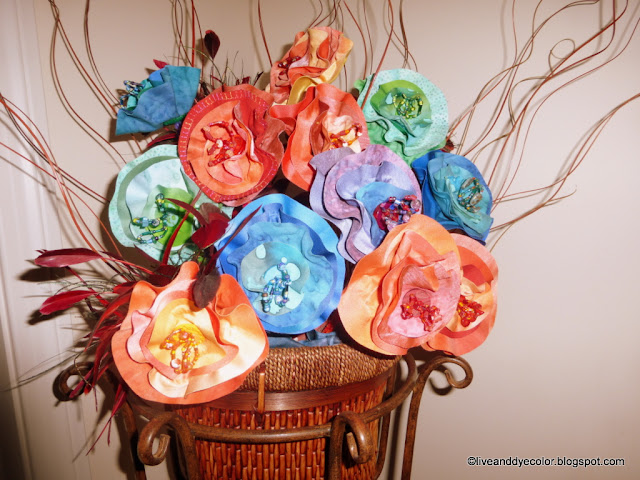My father smoked a pipe. Before they were called fancy "chenille
sticks", bendable, flexible, light, cheap pipe-cleaners were used
through the ages to clean pipes. They were also purloined through the
ages to make stick figure dolls because they are wired. The wire is
buried in a soft coating, so it will not poke through fabric flower
circles, but petals containing pipe cleaners can be made to drape! Eureka! Disclaimer: If you do not hide them, your cats will also go to
extraordinary lengths to steal them.They contain wire. Do not let your
cats steal them!
How to get the chenille stick into the flowers? I could sew a channel, but that is fiddly work. I could fuse it between the circles so the circles are finished off at the same time? Two-fer. Love it. Off to find drinking glasses, and other kitchen objects to make
cardboard templates. All those cardboard flyers you get in the mail? Keep them for craft projects.
So, layers of petals from small
to large, my flower is taking shape. Silk is best to use for maximum drape, but since I want to use some cotton, I am going to use MistyFuse instead of WonderUnder, for a softer fused fabric.
 |
| Chenille sticks for bendability |
I have cut two petals of the same size for each layer. 4 layers I think should do it. If the chenille stick is at least a centimeter, or finger width, from the edge, I can fuse the edge firmly. For the biggest petals, some funky bending will give me more flex. The circles are fused with the chenille stick as the sandwich filling. The edges don't match exactly, what a surprise...but I intend to trim them once the fusing is done, so no problem there. Frieda Anderson has some good fusing tips
here. Read them if you haven't fused before. The potential for a sticky mess definitely exists, and it is more fun to make flowers than clean an iron. Trust me on this...
Once the fused petal has cooled, I can trim each side until no fusible is visible, then time for a last hard ironing to seal that edge firmly. The chenille stick has made a shiny mark on the biggest petal, but it is going to be bent, and partially covered by the next petal, so no worries there. I am not a perfectionist, can you tell?
Now to make the stems. 18 gauge florist's wire is a good weight. A simple wooden craft clothes pin saves my fingers and wrist. With the end of the wire in the slit in the clothes pin, a simple turn of the clothes pin gives me a nice spiral with the stalk of the wire near the center. This will make a support for the flower, so it doesn't flop.
 |
| Clothespin to the rescue of sore fingers |
 |
| Wire support for fabric flower |
The components are coming together nicely!
Next challenge, will be to separate the petals. I think beads will make good spacers. Then I need a focal point. Wired bead stamens will be fun, and I can pull in the fabric colors. If I use a large button, I can attach the stamen through the top of the button, and work down to the last, biggest layer. This allows me to camouflage all the messy ending bits and attach the stem at the same time! I have a plan! Now I need some coffee!
Next post will show how to put all the bits together to make something like this.
 |
| Fabric flower with drape and dimensionality |




















